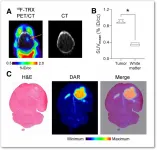(Press-News.org) As Xi'an Jiaotong-Liverpool University researchers completed their research on coloured architectural concrete, they found a surprising result--green pigmented cement had impurities that produced porous, poor quality concrete. Meanwhile, red and blue pigments had little effect.
The research was conducted by Mehreen Heerah, a graduate of XJTLU's Department of Civil Engineering, Dr Graham Dawson of XJTLU's Department of Chemistry, and Isaac Galobardes of Mohammed VI Polytechnic University.
Pigmented architectural concrete is used as a visually appealing alternative to grey concrete, such as in Barcelona's Ciutat de la Justícia, explains Dr Dawson. As the demand for pigmented architectural concrete grows, so does the importance of this research.
Not easy being green
"The characteristics of red and blue pigments used in the study were established in the existing research literature. However, the characteristics of the green pigment was not usual," says Dawson.
"The results for the red and blue pigments were quite close to our expectation," Heerah says. "On the other hand, we did not expect the drastic effect of green pigment on the properties of the mortar. In fact, we expected that a greater increment in strength with the green pigment compared to the other two."
That's because green pigment in products is based upon chromium oxide, which increases the strength of the mix when hydrated.
So why was green concrete found to be substandard?
The answer lies in how it was produced with damaging impurities, says Dr Dawson.
"Chemical products are used to produce pigments," he explains. "Sometimes, pigments present simple chemical components and other combinations of them to obtain different colours."
The offending impurity that weakened the green concrete was muscovite; a mineral used to produce green pigment for other industrial uses. When hydrated with cement, muscovite generated significant quantities of a component that causes excessive porousness, which results in a reduction in strength and longevity.
"However, other studies have found that there is no adverse effect when using green pigment consisting solely of chromium (III) oxide, with no muscovite," says Heerah.
Mix it up
The cement samples were produced with three different pigments--blue cobaltous aluminate, green chromium oxide and red iron oxide pigment--at three different levels: 1, 5 and 10%.
The researchers tested two types of cement to understand how these admixtures and by-products affect the properties of the resulting concrete.
The four-part experiment first tested water absorption to evaluate the change in physical properties, and then determined the hydration properties of the samples.
Next, the kinetics of hydration were studied through the evolution of the temperature of each mix. Finally, the researchers examined the flexural and compressive strength to understand the effect of pigment on mechanical strength.
The research established that the morphology of hydration products and kinetics was related to the samples' compressive strength.
The poor performance of the green pigment stood out compared to the minimal effects of the red and blue.
The research also discovered that the cobaltous aluminate oxide (blue) and iron (III) oxide (red) pigments could be used with both Portland and Portland Composite cement without weakening the concrete's strength.
Less impact
Researchers also improved upon an existing equation used for estimating the real-time compressive strength of the pigmented mortar, Heerah says.
Dr Galobardes explains: "Using this equation avoids making the destructive tests used to estimate the mechanical properties of concrete.
"This eliminates waste and lowers carbon dioxide emissions and costs related to the production of the samples used in the tests."
While pigments themselves do not reduce carbon emissions produced by concrete, the research indicates that they are safe to use with eco-cements.
Cement mixes such as Portland Composite Cement, which includes ground granulated blast-furnace slag (GGBS) and fly ash are expected to achieve reduced carbon emissions in coming years.
INFORMATION:
New research from the University of Otago debunks a long-held belief about our ancestors' eating habits.
For more than 60 years, researchers have believed Paranthropus, a close fossil relative of ours which lived about one to three million years ago, evolved massive back teeth to consume hard food items such as seeds and nuts, while our own direct ancestors, the genus Homo, is thought to have evolved smaller teeth due to eating softer food such as cooked food and meats.
However, after travelling to several large institutes and museums in South Africa, Japan and the ...
About six gigatons -- roughly 12 times the mass of all living humans -- of carbon appears to be emitted over land every year, according to data from the Chinese Global Carbon Dioxide Monitoring Scientific Experimental Satellite (TanSat).
Using data on how carbon mixes with dry air collected from May 2017 to April 2018, researchers developed the first global carbon flux dataset and map. They published their results in Advances in Atmospheric Sciences.
The map was developed by applying TanSat's satellite observations to models of how greenhouse gasses are exchanged among Earth's atmosphere, land, ...
Reston, VA--A new radiotracer that detects iron in cancer cells has proven effective, opening the door for the advancement of iron-targeted therapies for cancer patients. The radiotracer, 18F-TRX, can be used to measure iron concentration in tumors, which can help predict whether a not the cancer will respond to treatment. This research was published in the July issue of the Journal of Nuclear Medicine.
All cancer cells have an insatiable appetite for iron, which provides them the energy they need to multiply. As a result, tumors have higher levels of iron than normal tissues. Recent advances in chemistry have led scientists to take advantage of this altered state, targeting the expanded cytosolic ...
MUSC Hollings Cancer Center was one of 28 clinical sites around the world that participated in the LOTIS-2 trial to test the efficacy of Loncastuximab tesirine, a promising new treatment for aggressive B-cell lymphoma. The results of the single-arm, phase 2 trial were published online in May 2021 in Lancet Oncology.
Brian Hess, M.D., a Hollings researcher and lymphoma specialist at MUSC Health, was instrumental in bringing the phase 2 trial to Hollings. The manufacturer of Loncastuximab tesirine, ADC Therapeutics S.A., sponsored the trial.
B-cell non-Hodgkin lymphoma (NHL) is a blood cancer that begins in the lymph nodes, spleen or bone marrow. Diffuse large B-cell lymphoma (DLBCL) is the most common subtype of aggressive NHL. New treatment options are vital for patients with DLBCL. ...
Due to the global efforts to meet sustainability standards, many countries are currently looking to replace concrete with wood in buildings. France, for example, will require that all new public buildings will be made from at least 50 percent wood or other sustainable materials starting in 2022.
Because wood is prone to degradation when exposed to sunlight and moisture, protective coatings can help bring wood into wider use. Researchers at Aalto University have used lignin, a natural polymer abundant in wood and other plant sources, to create a safe, low-cost and high-performing coating for use in construction.
'Our new coating has great potential to ...
A new optogenetic tool, a protein that can be controlled by light, has been characterized by researchers at Ruhr-Universität Bochum (RUB). They used an opsin - a protein that occurs in the brain and eyes - from zebrafish and introduced it into the brain of mice. Unlike other optogenetic tools, this opsin is not switched on but rather switched off by light. Experiments also showed that the tool could be suitable for investigating changes in the brain that are responsible for the development of epilepsy.
The teams led by Professor Melanie Mark from the Behavioural Neurobiology Research Group and Professor Stefan Herlitze from the Department ...
As the SARS-CoV-2 virus that causes COVID-19 continues to evolve, immunologists and infectious diseases experts are eager to know whether new variants are resistant to the human antibodies that recognized initial versions of the virus. Vaccines against COVID-19, which were developed based on the chemistry and genetic code of this initial virus, may confer less protection if the antibodies they help people produce do not fend off new viral strains. Now, researchers from Brigham and Women's Hospital and collaborators have created an "atlas" that charts how 152 different antibodies attack a major ...
Many species within Kenya's Tana River Basin will be unable to survive if global temperatures continue to rise as they are on track to do - according to new research from the University of East Anglia.
A new study published in the journal PLOS ONE today outlines how remaining within the goals of the Paris Agreement would save many species.
The research also identifies places that could be restored to better protect biodiversity and contribute towards global ecosystem restoration targets.
Researcher Rhosanna Jenkins carried out the study as part of her PhD at UEA's School of Environmental Sciences.
She said: "This research shows how many species within Kenya's Tana River Basin will be unable to survive if global temperatures continue to rise as they are on track to do.
"But remaining ...
For young soccer players, participating in repetitive technical training activities involving heading during practice may result in more total head impacts but playing in scrimmages or actual soccer games may result in greater magnitude head impacts. That's according to a small, preliminary study released today that will be presented at the American Academy of Neurology's Sports Concussion Conference, July 30-31, 2021.
"Headers are a fundamental component to the sport of soccer. Therefore, it is important to understand differences in header frequency and magnitude across practice and game settings," said study author Jillian Urban, PhD, MPH, of Wake ...
University of Virginia School of Medicine researchers have discovered a previously unknown repair process in the brain that they hope could be harnessed and enhanced to treat seizure-related brain injuries.
Common seizure-preventing drugs do not work for approximately a third of epilepsy patients, so new and better treatments for such brain injuries are much needed. UVA's discovery identifies a potential avenue, one inspired by the brain's natural immune response.
Using high-powered imaging, the researchers were able to see, for the first time, that immune cells called microglia were not just removing damaged material after experimental seizures but actually appeared to be healing damaged neurons.
"There has been mounting generic support for the idea that microglia ...



